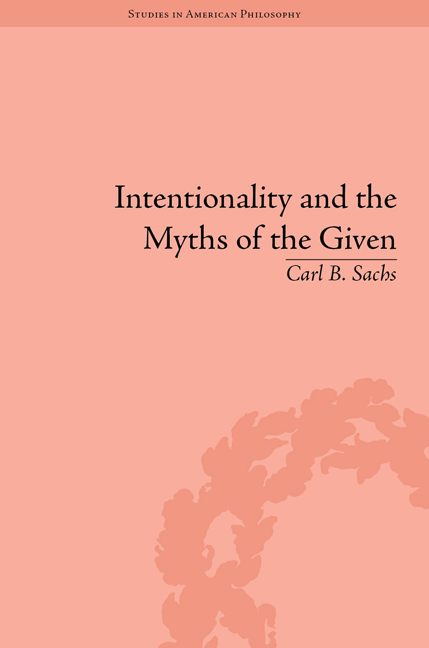Book contents
- Frontmatter
- Contents
- Acknowledgements
- Introduction: Why a New Account of Intentionality?
- 1 Intentionality and the Problem of Transcendental Friction
- 2 The Epistemic Given and the Semantic Given in C. I. Lewis
- 3 Discursive Intentionality and ‘Nonconceptual Content’ in Sellars
- 4 The Retreat from Nonconceptualism: Discourse and Experience in Brandom and McDowell
- 5 Somatic Intentionality and Habitual Normativity in Merleau-Ponty's Account of Lived Embodiment
- 6 The Possibilities and Problems of Bifurcated Intentionality
- Conclusion
- Appendix: Is Phenomenology Committed to the Myth of the Given?
- Works Cited
- Notes
- Index
1 - Intentionality and the Problem of Transcendental Friction
- Frontmatter
- Contents
- Acknowledgements
- Introduction: Why a New Account of Intentionality?
- 1 Intentionality and the Problem of Transcendental Friction
- 2 The Epistemic Given and the Semantic Given in C. I. Lewis
- 3 Discursive Intentionality and ‘Nonconceptual Content’ in Sellars
- 4 The Retreat from Nonconceptualism: Discourse and Experience in Brandom and McDowell
- 5 Somatic Intentionality and Habitual Normativity in Merleau-Ponty's Account of Lived Embodiment
- 6 The Possibilities and Problems of Bifurcated Intentionality
- Conclusion
- Appendix: Is Phenomenology Committed to the Myth of the Given?
- Works Cited
- Notes
- Index
Summary
Original Intentionality and the Naturalist Challenge
In his insightful (and delightful) ‘The Intentionality All-Stars’, John Haugeland examines the problem of how there can be original intentionality within a naturalistic world-view. How, he asks, can any part of the natural world bear an intentional relation to any other part? ‘How can there be norms among the atoms in the void?’. I use ‘original intentionality’ here in Haugeland's sense: ‘original’ contrasts with ‘derived’, with the kind of intentional, semantic content that sentences and signs have. Since not all semantic content can be derived, the argument goes, there must be original intentionality. Put otherwise, original intentionality does not mean a particular kind of intentionality but rather ground-level, ‘original’ cases of intentionality that need to be understood in order for other cases of intentional content to be understood.
This is not to say that any particular item has its own intrinsic semantic content independent of all other semantic contents – that, I will show below, is an episode of the Myth of the semantic Given. Rather, it is to say that the entire relational system of semantic contents does not have its content conferred upon it by something else; intentional content is a holistic property of the system, not of any specific part of the system. Nor does “original” here mean ineffable, private, inexplicable, or unexplained.
- Type
- Chapter
- Information
- Intentionality and Myths of the GivenBetween Pragmatism and Phenomenology, pp. 7 - 20Publisher: Pickering & ChattoFirst published in: 2014



